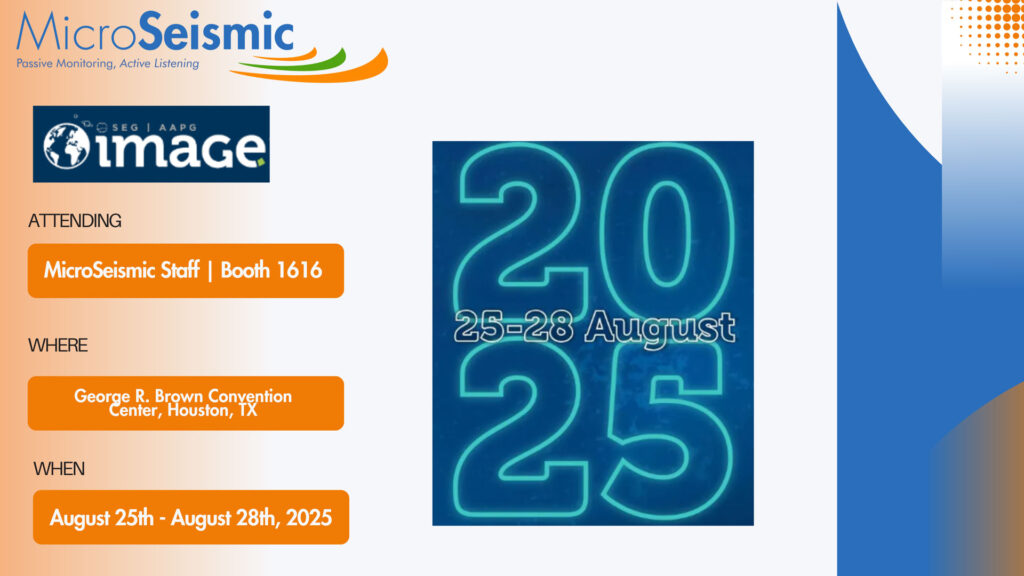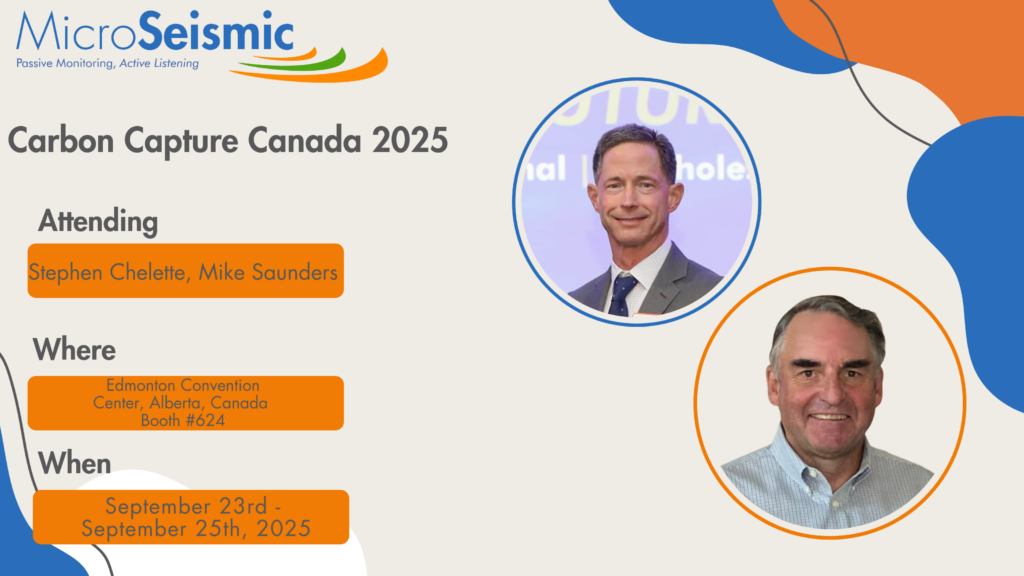
- This event has passed.
URTEC
2017 URTEC Booth Presentation Schedule | Booth #819
| Monday, July 24 10:00am – 6:00pm |
||
| 10:05 am | Estimating Unconventional Wells’ Productivity and Drainage Volume – Eagle Ford Case Study Hasan Shojaei, Reservoir Engineer |
|
| 10:25 am | Microseismic-Based Reservoir Simulation: FINALLY! Carl Neuhaus, VP Engineering |
|
| 10:45 am | The Case For A BuriedArray In The Vaca Muerta Andrew Hill, Analysis Manager |
|
| 11:05 am | Full Waveform Downhole Microseismic Mike Thornton, CTO |
|
| 11:25 am | Seeing the Big Picture – How to Use Stress Shadowing to Drive Stage Spacing Jon McKenna, Completions Evaluation Team Lead |
|
| 3:10 pm |
Fully Capturing The Focal Sphere For Accurate Reservoir Analyses |
|
| 3:30 pm |
Full Waveform Downhole Microseismic |
|
| 5:15 pm | Estimating Unconventional Wells’ Productivity and Drainage Volume – Eagle Ford Case Study Hasan Shojaei, Reservoir Engineer |
|
| 5:45 pm | Microseismic-Based Reservoir Simulation: FINALLY! Carl Neuhaus, VP Engineering |
|
| 6:15 pm | The Case For A BuriedArray In The Vaca Muerta Andrew Hill, Analysis Manager |
|
| Tuesday, July 25 10:00am – 6:00pm |
||
| 10:15 am | Fully Capturing The Focal Sphere For Accurate Reservoir Analyses Orlando Teran, Structural Geologist |
|
| 10:35 am | Seeing the Big Picture – How to Use Stress Shadowing to Drive Stage Spacing Jon McKenna, Completions Evaluation Team Lead |
|
| 12:00 pm |
Lunch and Learn |
|
| 3:10 pm | Microseismic-Based Reservoir Simulation: FINALLY! Carl Neuhaus, VP Engineering |
|
| 3:30 pm |
Estimating Unconventional Wells’ Productivity and Drainage Volume – Eagle Ford Case Study |
|
| 5:05 pm | The Case For A BuriedArray In The Vaca Muerta Andrew Hill, Analysis Manager |
|
| 5:25 pm | Full Waveform Downhole Microseismic Mike Thornton, CTO |
|
| 5:45 pm | Fully Capturing The Focal Sphere For Accurate Reservoir Analyses Orlando Teran, Structural Geologist |
|
| Wednesday, July 26 9:00am – 1:00pm |
||
| 8:30 am |
Oral Presentation |
|
| 10:15 am |
Microseismic-Based Reservoir Simulation: FINALLY! |
|
| 10:35 am | The Case For A BuriedArray In The Vaca Muerta Andrew Hill, Analysis Manager |
|
| 10:55 am | Seeing the Big Picture – How to Use Stress Shadowing to Drive Stage Spacing Jon McKenna, Completions Evaluation Team Lead |
|
| 8:30 am |
Oral Presentation |
|
BOOTH TALK ABSTRACTS
Microseismic-Based Reservoir Simulation: FINALLY!
Understanding how the reservoir reacts to a particular combination of treatment parameters and optimizing the design based on those observations is key. In this talk, we show results from a three-well pad in the Midland basin using historic production data, well logs, PVS and core data, as well as other available offset data. We will show how this analysis helped meet the client’s project goals for determining optimum wellbore spacing and evaluating the completion design regarding cluster spacing and stage lengths.
Fully Capturing The Focal Sphere For Accurate Reservoir Analyses
The energy emitted from a fracturing source contains a wealth of information about the fracture geometry and the in situ stresses. However, the amount of uncertainty in the source characteristics is strongly dependent on the sampling spread (i.e. surface array vs. downhole array of geophones). In this talk, we will be reviewing the benefits of surface microseismic in fully capturing the focal sphere and how this information can be used for performing reservoir geomechanical and engineering analyses as well as understanding the predictability of the frac.
Full Waveform Downhole Microseismic
Limited aperture is a significant constraint in downhole microseismic monitoring affecting the accuracy of both location and velocity estimates. Full waveform imaging maximally uses all available information from this limited data to produce superior estimates as compared to traditional location techniques.
The Case For A BuriedArray In The Vaca Muerta
Surface microseismic monitoring is a very effective tool that can be used to inform decisions on treatment, well and pad development. However, in some cases, when multiple pads or an entire field is to be developed, a BuriedArray may be a better and more cost effective option to gather more information over a larger area and a longer duration. This information includes stress state variations, completion design and well placement optimization.
Seeing the Big Picture – How to Use Stress Shadowing to Drive Stage Spacing
Stress inversion of microseismic data collected in the Williston Basin shows that the initial magnitude of SH and Sh are close in absolute magnitude and are subject to flipping relative magnitudes during the treatment. In this talk we will show how results were combined with induced stress effects to identify the optimal stage spacing when SH=Sh yielding more complex fractures.
Estimating Unconventional Wells’ Productivity and Drainage Volume – Eagle Ford Case Study
Microseismic-derived permeability enhancement results are integrated with PVT, core and well-log data to build a detailed reservoir simulation model for a 5-well pad in the Eagle Ford. Individual well productivities (PIndex) are predicted, and subsequently calibrated using actual production data (i.e. history matching). The resulting reservoir drainage patterns (DIndex) are used to evaluate wellbore spacing and completion design.


